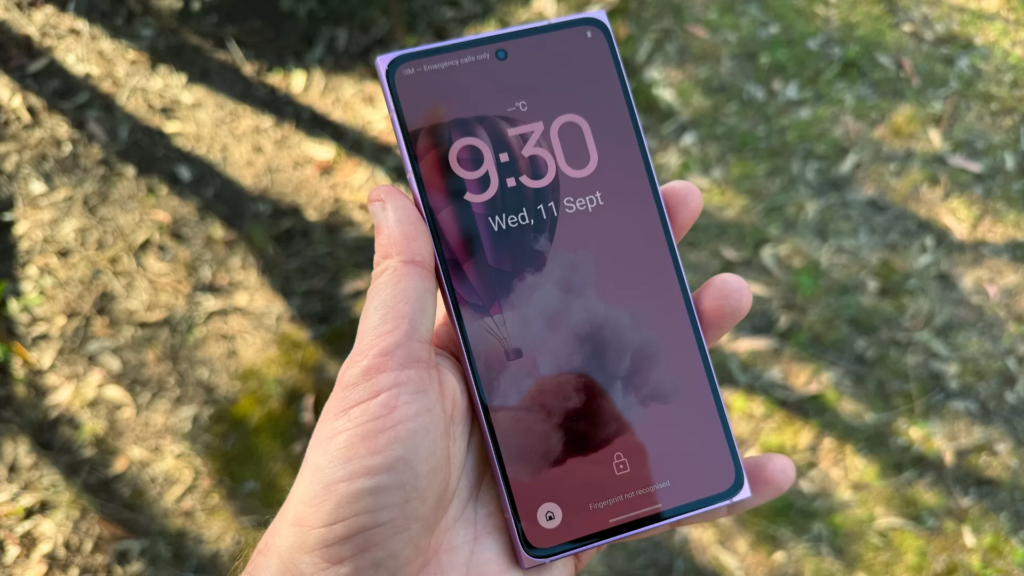In a crowded Android market, standing out isn’t easy. Every brand seeks that elusive “X” factor to grab attention. From Nothing Phone 2’s striking LED design to Google’s Pixel 8a dominating in camera performance, competition is fierce. Enter the HMD Skyline, aiming to set itself apart with two standout features: Qi2 wireless charging and self-repairability. But can these innovations make up for its shortcomings?
Design and Display: A Clunky Trade-off
HMD markets the Skyline as a phone for creators, but its design doesn’t quite reflect that. The boxy, uncomfortable frame has more in common with old Microsoft Lumia phones than modern Android devices. Measuring 159.7 x 75.6 x 8.9mm and weighing 208g, it’s bulkier than many competitors. While the power and volume buttons are well-placed and the side-mounted fingerprint scanner is functional, the overall look lacks appeal. The design, particularly the thick bezels around its 6.5-inch pOLED display, feels outdated.
Please follow us on Facebook and Twitter.
However, the display itself performs well. With a 1080 x 2400 FHD+ resolution and up to 144Hz refresh rate, it provides smooth scrolling and vivid visuals. Yet, its 1,000 nits of brightness fall short compared to rivals like the Samsung Galaxy A-series, making outdoor viewing difficult.
Hardware and Features: Qi2 and Repairability
Where the Skyline really shines is in its Qi2 wireless charging—a first for Android phones. Much like Apple’s MagSafe, Qi2 allows users to magnetically snap the phone to a charger, making wireless charging more efficient. While it only supports 15W wireless charging, the alignment with magnetic coils ensures a faster, more stable charge.

Another standout feature is its repairable design. Thanks to a partnership with iFixit, users can easily replace components like the battery or screen with the help of a $15 Minnow Driver Kit. This makes the Skyline more sustainable and affordable over time. However, as of now, replacement parts are unavailable, which could be a downside for early adopters. The phone ships with a USB-C cable but no charging brick, a common trend nowadays.
Performance: Behind the Times
Powered by a Snapdragon 7s Gen 2 processor with 8GB of RAM and 256GB of storage, the HMD Skyline offers decent performance but feels dated compared to similarly priced devices. Priced at $499, it sits in the same bracket as the OnePlus 12R and Google Pixel 8a, both of which boast better specs for the same price. The OnePlus 12R, for instance, offers a Snapdragon 8 Gen 2 chip and a larger 5,500mAh battery, making it a tough competitor.
For everyday tasks like browsing, social media, and light gaming, the Skyline performs adequately. However, it struggles with high-end games or multitasking with resource-heavy apps. While Android 14 offers a clean, near-stock experience, the phone comes preloaded with a bit of bloatware like Booking.com and Facebook. HMD’s Detox Mode (a feature to block app notifications and categorize apps) isn’t available yet, though it promises more customization when it arrives.
It is reported that the Skyline’s two years of OS support and three years of security updates are a significant drawback compared to Google’s seven years of updates for the Pixel 8a and four years from OnePlus. This short software lifespan somewhat undermines the phone’s repairable hardware, leaving users to potentially consider an upgrade after just a couple of years.
Camera Performance: Adequate but Not Exceptional
The Skyline comes equipped with a 108MP main camera, a 13MP ultrawide, and a 50MP telephoto lens with 4x zoom. While these sound impressive on paper, the actual results are average. Photos are fine for social media but lack the rich detail and AI enhancements found in competitors like the Pixel 8a. Shots taken in backlit conditions often appear too dark or suffer from visual noise. The 50MP front camera is the star of the show, offering sharp, colorful selfies with a pleasing bokeh effect.
Battery Life and Charging: Qi2 for the Win
The Skyline features a 4,600mAh battery, enough to last a full day of average use, with some juice left for the next morning. Paired with 33W wired charging, the phone charges from 20% to full in about an hour, while the 15W Qi2 wireless charging takes just over two hours. While not the fastest, it’s efficient and convenient, especially for users on the go.

HMD Skyline Specifications
| Specification | Details |
| SoC | Snapdragon 7s Gen 2 |
| Display Type | pOLED |
| Display Size | 6.55 inches |
| Display Resolution | 1080 x 2400 (FHD+) |
| RAM | 8GB |
| Storage | 256GB |
| Battery | 4600mAh (replaceable) |
| Charging Speed | 33W wired / 15W wireless (Qi2) |
| Ports | USB-C |
| Operating System | Android 14 |
| Front Camera | 50MP |
| Rear Cameras | 108MP main / 13MP ultrawide / 50MP telephoto |
| Cellular Connectivity | 5G |
| Wi-Fi Connectivity | Wi-Fi 6e |
| Bluetooth | Bluetooth 5.2 |
| Dimensions | 159.7 x 75.6 x 8.9 mm |
| Weight | 208g |
| IP Rating | IP54 |
| Colors | Twisted Black / Neon Pink |
| Stylus | No |
| Price | $499 |
The Verdict: Solid, But Falls Short
Ultimately, the HMD Skyline delivers on its promise of being an innovative, repairable midrange phone, but it struggles to compete with other offerings at its price point. While Qi2 charging and easy repairs are attractive features, they aren’t enough to offset the dated design, limited software support, and lackluster performance. For users focused on sustainability and repairability, the Skyline is a compelling choice. However, if you’re looking for the best midrange performance, there are better options on the market.





